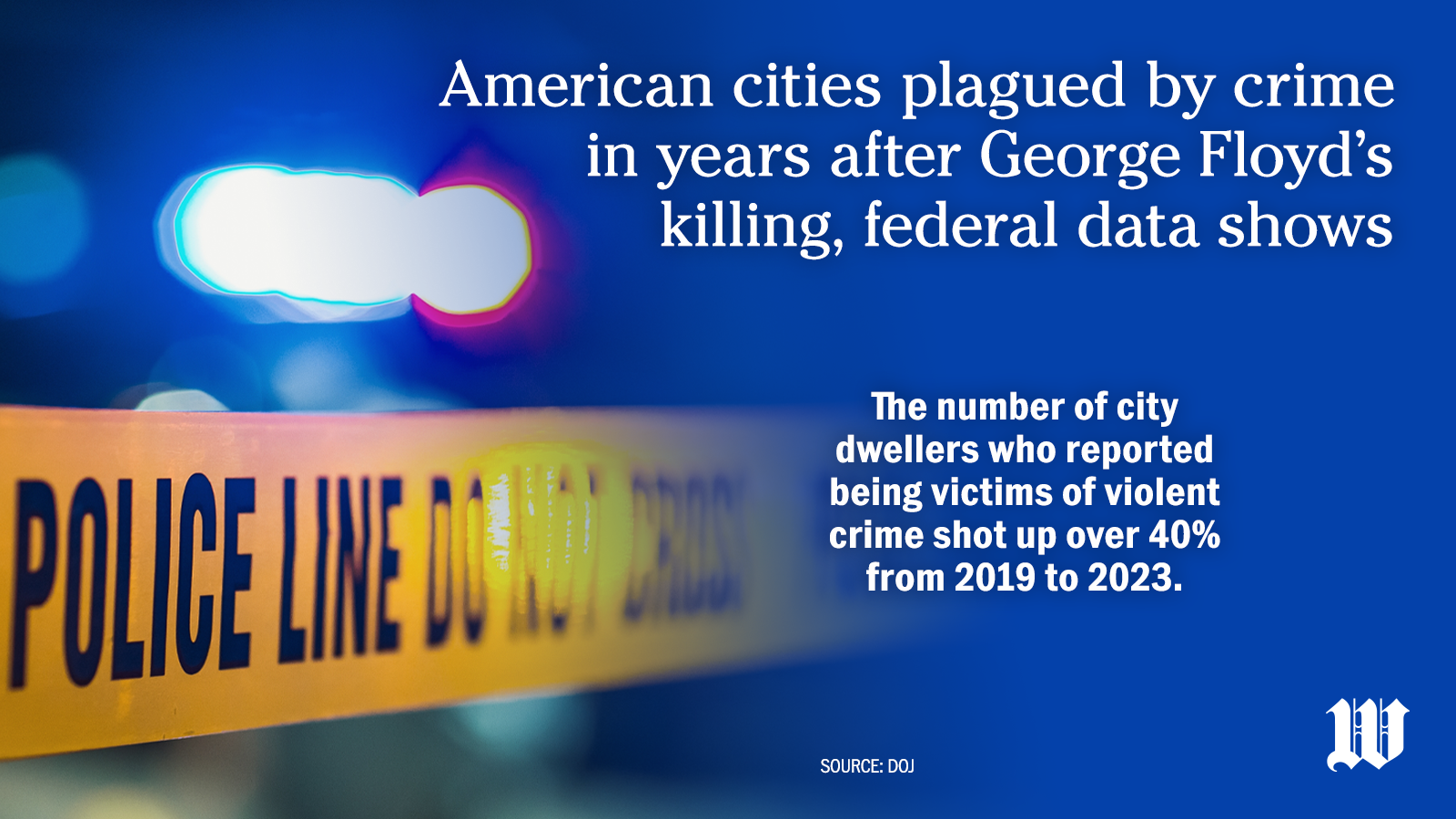A surge in rapes, muggings and shootings has taken hold in American cities since 2019, according to an analysis of federal data, and researchers say the violence is a product of Democrats’ anti-police, pro-criminal policies enacted after the death of George Floyd.
The number of city dwellers who reported being victims of violent crime shot up over 40% from 2019 to 2023, according to the Justice Department’s National Crime Victimization Survey.
When the Justice Department excluded simple assault — the lowest level, most common felony — from its survey responses, the victimization rate in urban areas jumped more than 54% in that period.
Burglaries and other property theft were up 26% from 2019 to 2023. The federal survey does not include data on business-related property crime, so the smash-and-grab robberies and rampant shoplifting in metropolises aren’t factored into the findings.
The crime surge is confined to cities. The analysis showed little change in rural and suburban parts of the U.S.
Veteran crime statistician Jeff Anderson, who first spotted the spike in urban crime rates in the federal data made public in September, said “leftist ideologues” working as top prosecutors are behind the rift.
He said the prosecutors’ inclinations to forgive criminal behavior and harp on police procedures, especially after the “defund the police” movement motivated by Floyd’s death in 2020, explains the difference between New York City, Chicago and Los Angeles and their neighbors living outside city lines.
“They’ve adopted a very constrained view of policing, and they decided to rerun the experiments of years ago about what happens if we go soft on crime — I think we’re seeing the result,” said Mr. Anderson, a former director of the Bureau of Justice Statistics who now runs the American Main Street Initiative think tank.
The federal crime survey is conducted annually by the Census Bureau and includes responses from roughly 240,000 Americans.
Census takers interview people, often in person, about whether they have been victims of “nonfatal personal crimes,” including rape, sexual assault, robbery, aggravated or simple assault, and invasive thefts such as purse snatching and pickpocketing.
About 45% of the respondents said they didn’t report their crimes to police, which is comparable to the Bureau of Justice Statistics rate in 2019.
Mr. Anderson said the survey results counter the White House narrative that national crime rates are down.

In September, the FBI’s comprehensive annual Crime in the Nation Statistics, a separate report most often cited by the Biden administration, showed violent crime in the nation down 3% from 2022 to 2023.
In the agency’s most recent Quarterly Uniform Crime Report, which covers January through June, the FBI said violent crime fell 10% and property crime fell 13% nationwide compared with last year.
President Biden celebrated the FBI’s quarterly numbers by pointing out that the year-over-year homicide rates dropped at “record speed.”
“These record decreases follow the historic declines in crime in 2023, including the largest-ever decrease in the homicide rate,” Mr. Biden said. “Communities across our country are safer now than when I took office.”
Crime observers called out the FBI’s numbers for their lack of precision, as The Washington Times has reported.
The agency recorded 499 homicides in Chicago last year, while the Major Cities Chiefs Association, a professional police organization, recorded 617. Dallas and Baltimore also had sizable gaps in what the FBI and the MCCA reported.
The FBI typically pushes out preliminary data that is quietly revised in the months and even years that follow.
John Lott from the Crime Prevention Research Center said the agency updated its 2021 and 2022 numbers this fall.
The FBI initially reported that crime dropped 1.7% nationally from 2021 to 2022. As the data firmed up, it now reports that crime increased 4.5%.
The revisions caught the eye of lawmakers Thursday.
The Republican-led House Oversight and Accountability Committee ordered the FBI to turn over documents detailing the changes and any communications the agency had with the Justice Department or the White House.
“The Committee is concerned that the FBI’s recent failures to report accurate crime data are politically motivated,” Rep. James Comer, Kentucky Republican, said in his letter to FBI Director Christopher A. Wray.
Mr. Anderson said the FBI is not the Justice Department’s statistical agency, so relying on it to provide concrete data is “a little bit of a reach.”
That point is emphasized by the agency’s shift to a more granular reporting protocol in 2021, which caused some local police departments to file incomplete numbers to the FBI or opt out of submitting data.
Mr. Anderson said the dramatic changes in the federal survey’s victimization rate warrant more attention, especially from media outlets that have cited the FBI’s crime numbers for defanging former President Donald Trump’s talking points about crime in big cities.
“We can see from the NCVS that there is this massive crime spike in urban areas,” he said. “The press is busy reporting this 3% drop in crime from the FBI, and that’s just an estimate that is by no means exact, and they’re ignoring a 40% increase in violent crime. That’s a huge change.”
• Matt Delaney can be reached at mdelaney@washingtontimes.com.




Please read our comment policy before commenting.